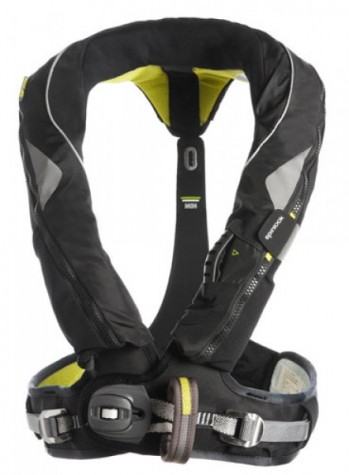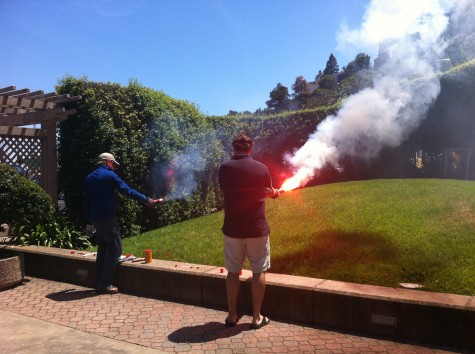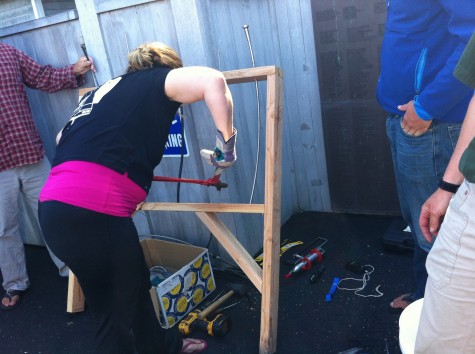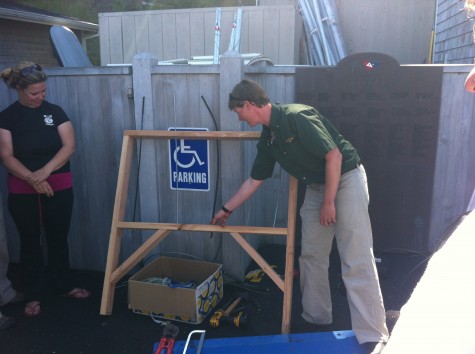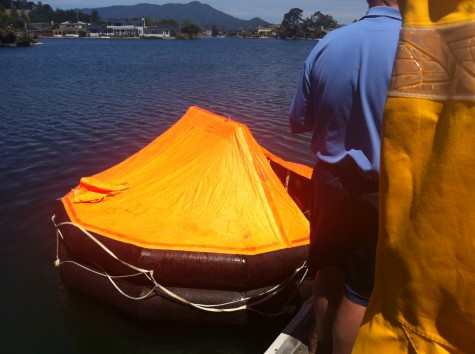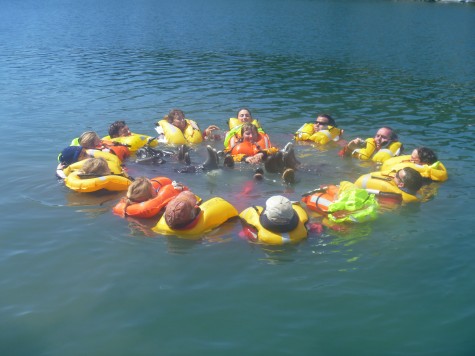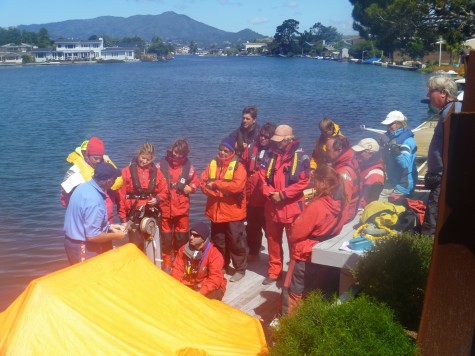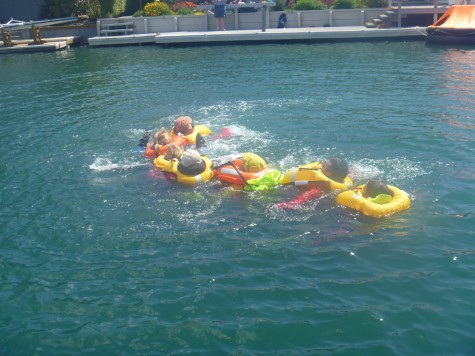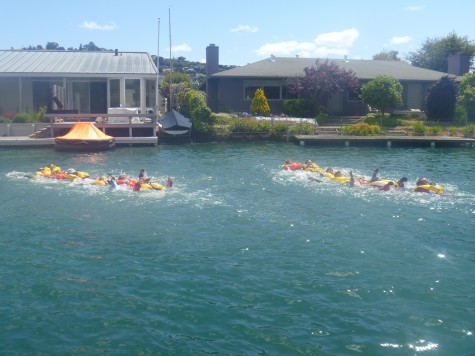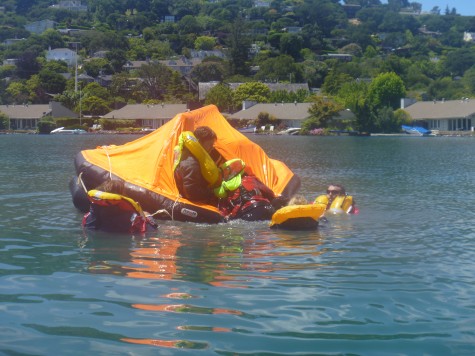Safety at Sea
Soft Wood Plugs
The rule below is required for all boats racing no matter what catagory. Obviously it would also be a great idea if all cruising boats complied as no matter what you are doing in your boat if you can’t plug the hole it will sink!
4.03 Soft Wood Plugs
Soft wood plugs, tapered and of the appropriate size, shall be attached or stowed adjacent to the appropriate fitting for every through-hull opening.
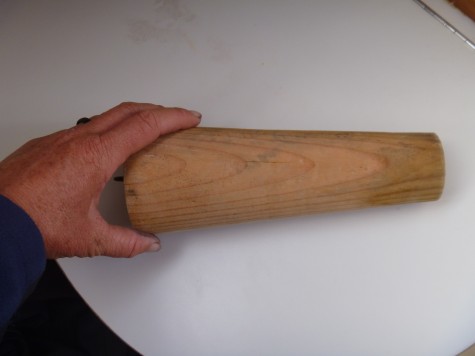
As you can tell from my hand in the photo this is a large bung! For boats with waterballast scoops that is a hole that could need plugging so a custom one needs to be made. I take fencing material 4 x 4’s glue them together and then turn the plugs down on a lathe.
The packs that you can buy at West Marine are pretty useless for most of my boats as only 2 or 3 work for the thru hulls and the rest are too small. It is a requirement to have them attached to the thru hulls rather than in a bag somewhere in the boat the disadvantage of this is that the wood ends up swelling up as it picks up water in the bilge. Really you want the plugs to be dry so when they are pounded into the hole they swell up when the water hits them and therefore become well wedged in the hole. So keeping a few in a ziplock bag in the dry is also a useful thing to do and will allow you to intially plug the hole with the one next to the thru hull and then change it out with a dry one after the fact.
Organising your flares – Cat 2
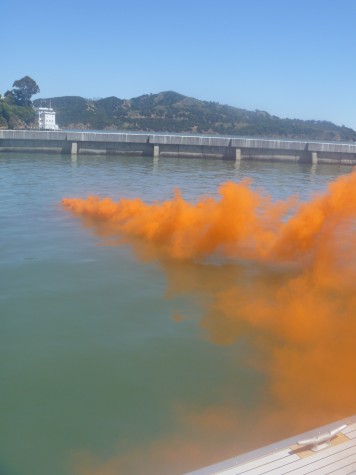
Orange smoke flare being set off in the SFYC harbour.
After seeing the difference between SOLAS and non SOLAS flares at the Sea Survival course I helped run at SFYC many of my clients asked that I put together a OSR Cat 2 pack of SOLAS flares. I put them together in a way I have been doing for a number of years. The Cat 2 requirement is for 4 red parachute flares, 4 red handheld flares and 2 orange smoke flares.
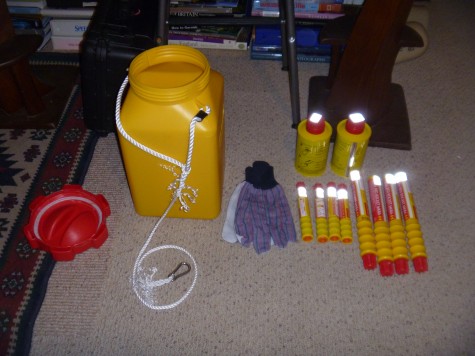
As you can see I put a small square of adhesive reflective tape on the firing ends of the flares so if it is dark it is easy to figure out which end is the important end! Also in each box is a set of gloves to wear to decrease the likliehood of getting burnt. I splice on a lanyard with a clip to allow the box to be attached so it doesn’t float away.
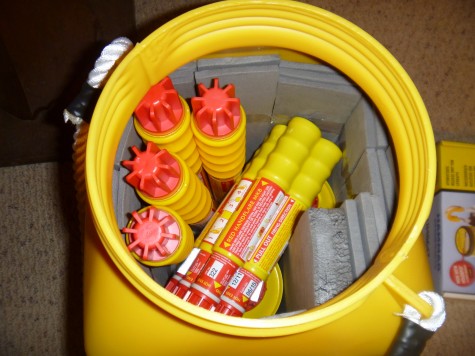
I fill the box with foam to ensure that the box is inherently bouyant and doesn’t sink if it fills with water.
Stability Guidance Booklet
Several people have asked me recently about STIX numbers and vessel stability. The MCA has a great booklet which can be seen at http://www.dft.gov.uk/mca/197-070_mca_stability_sv_web.pdf
Continuous education is a good thing. Those who came to our sea survival course keep it up please.
150N
Last night was potluck with my good friends and we got to talking about what we had been up to over the past few weeks since last potluck. I had Paul with me (sea survival instructor) and everyone wanted to know what we were teaching. As I had the 150N foam lifejacket in the back of my truck I brought it in along with my spinlock deck vest. So it became a teaching session on lifejackets and radio calls.
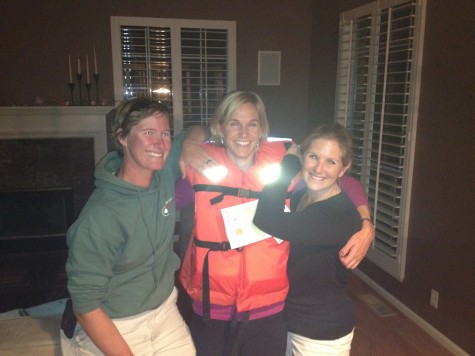
The lifejacket in the picture is the 150N jacket which you would have to wear racing in Cat 0, 1 and 2 races if you didn’t where an inflatable. San Francisco is the only place I race where people haven’t educated themselves as to why kayak vests are not the acceptable form of flotation for racing offshore. We are changing that! A kayak type vest has about 50N of bouyancy, no yoke collar (so it won’t turn you upright) and no crotch straps (so it will come over your head).
I obviously don’t wear the foam so my offshore lifejacket of choice is the Spinlock 150N pro sensor modified with a manual inflate I have been wearing one since they first came out. Why… well it has crotch straps (a lifejacket is useless without them), it has a splash hood so I don’t die of secondary drowning and it will roll me face up.
So the courses were a great success. We got 42 people through the course and we hope it is a start to changing the culture of safety within the bay.
What does M I P D A N I O stand for? Well it is an acronym for the contents of a Mayday message you would make in grave and imminent danger.
Mayday
Identification
Position
Nature of Distress
Assistance required
Number of people aboard
Any other information
Over
That’s all for now… have a great weekend. I will be racing up to Drakes Bay on Rhumb Boogie and back on Saturday and Sunday.
Sea survival course – flares and rigging
Sea Survival course – Liferaft training
ISAF Sea Survival Training
There is a change to the Safety training requirements in San Francisco that I have been trying to encourage since 2008. Indeed I attempted to organise my own ISAF Sea Survival course in 2008 but couldn’t get it together due to lack of seed money.
The current one day US Sailing Safety at Sea seminars do not fulfill the ISAF training regulations as they are one day with no practical requirements. There are very few offered in the US by US Sailing that do comply with ISAF rules. They are two day courses with the hands on training which is documented in Appendix G see http://www.sailing.org/documents/special-regs.php and have been offered by US sailing since 2007 with the top up hands on aspect.
Having taken both courses (multiple times) the two day ISAF one is not only a lot of fun but incredibly instructive. Until you have jumped in the water with your lifejacket on and your foulies you will not know how hard it is to move with boots on and it will encourage you to stay on the boat if at all possible! Until you have looked at flares and set them off you will not know that they all set off in a different way and that there is a large recoil. Until you pull someone twice your weight into a liferaft you won’t know that it is possible with the correct technique. Have I persuaded you yet?
Under the auspice of San Francisco Yacht Club we will be offering a two say ISAF Sea Survival course one on 2-3rd June and one on 4-5th June. If you are interested please email me at amperrin@racingyachtmanagement.com
Safety Regulations
Last night a group of us got together in Tiburon as many people didn’t want to spend time on their own at home without the support of friends in the sailing community. The sailing community is for many people their extended family. Some people are now at the stage in their grief of wanting to figure out what lessons are to be learnt from the accident and some are not.
I think the lessons to take away from this particular incident are quite a long way down the road as there needs to be a full investigation in MAIB style first. Currently there are too many confusing stories of how the whole thing unfolded on the water. The survivors will have different accounts as it most likely happened so fast they will each process different parts of the experience.
What is amazing is the reach that these 5 individuals had and this tragedy is not just impacting the sailing world. The Giants baseball team made a moving tirbute to one of the missing who was the first major league batgirl see
http://mlb.mlb.com/video/?play.jsp?content_id=20677679&to?pic_id&c_id=sf&tcid=vpp_copy_2?0677679&v=3
Accidents like this are normally a result of a cascade of tiny things piling up. Personally my bible is the Offshore Special Regulations and the reason why is that a group of people smarter than myself with more experience then myself wrote them. However much experience an individual has, there is always more that can be learned from others. They have gone through all the Marine Accident Investigations and come up with rules that are easy to comply with and are using up to date technology.
The race at the weekend was a Catagory 2 race and the safety rules to comply can be seen at http://www.sailing.org/documents/special-regs.php . In the past in my tips and tricks section on this website I have explained ways to comply with these rules and also the reasons individual ones are in existance. The rules are valuable because generally someone had to die for each particular one to come into being so when complying with them you are honoring that individuals memory. There is a book which is a little outdated but is very useful none the less written by Alan Green (who was at RORC when I started racing offshore at the age of 13) entitled Offshore Special Regulations Handbook. In the book he outlines the background to the regulations and explains how to interpret and apply them, with the aid of examples, pictures and quotations.
I have noticed a large difference in the two sailing communities that I am apart of that is the UK offshore racing scene and that of the Bay Area. In the UK I raced primarily in RORC races from the age of 13 this is the club that creates the safety regulations. Unlike the Bay Area it seems that the crew of the boats has a wider knowledge of the safety regulations and it is not just the skippers responsibility. This may be a result of the crew being a larger part of getting boats ready for the season and not leaving it to professional boat captains or the owners.
On a personal level I am purchasing a 406 PLB for my little brother who has started doing a lot of singlehanded racing I am also getting a new floating waterproof VHF which has DSC. The DSC feature means that when I set it off the boats in the immediate area will recieve my mayday and will know that I am in trouble. Another solution is to have an AIS transmitter see http://www.oceansafety.com/index.php?option=com_hikashop&ctrl=product&task=show&cid=850&name=kannad-safelink-r10-ais-srs&Itemid=34&category_pathway=79 however, AIS recievers are currently not in wide use in the US. In the UK most boats now have them. With my 406 PLB the coastguard will know I am in trouble and as it has 121.5Mhz they will be able to home in on my signal. With these two pieces of equipment I hopefully have help coming from two seperate places.
The issue of tethering seems to be what everyone is pointing at and again I believe there is rarely one solution and there are always points in a race where you have to disconnect yourself to do a manovere. I personally would prefer to be tethered because then I have a choice to disconnect myself from the boat should events unfold that mean being tethered is more dangerous than not being. You should be tethered in a way that allows you to disconnect. I like to have a nylon tether that gives rather than a dyneema one that snaps (see http://dmmclimbing.c…dyneema-slings/) and I prefer to have one that has a snap shackle which I can pull rather than having to get a knife out to cut my tether. Tethering when you are sitting in one position for a long time is always advisable and it should be to the required clipping in points to avoid everyone clipping onto a single jackline.
IMHO a lifejacket without crotch straps is useless and if offshore I always wear a lifejacket harness combo (a spinlock deckvest) rather than having a seperate lifejacket and harness. There is no point in being tethered to a jackstays or clipping points that haven’t been fitted properly the regulations have very detailed guidelines regarding how they are fitted and I have rarely seen them fully complied with. In my opinion the padeyes should be specifically used for this purpose and not in use for another purpose i.e. as a pushpit or pulpit, with a spinnaker sheet block attached etc.
4.04 Jackstays, Clipping Points and Static Safety Lines
4.04.1 The following shall be provided:
a) Jackstays:- shall be provided attached to through-bolted or welded deck plates or other suitable and strong anchorage fitted on deck, port
and starboard of the yacht’s centre line to provide secure attachments for safety harness
ii comprising stainless steel 1 x 19 wire of minimum diameter 5 mm (3/16 in), high modulus polyethylene (such as Dyneema/Spectra) rope or webbing of equivalent strength
iii which, when made from stainless steel wire shall be uncoated and used without any sleeving
iv 20kN (2,040 kgf or 4,500 lbf) min breaking strain webbing is recommended
4.04.2 Clipping Points:- shall be provided
a) attached to through-bolted or welded deck plates or other suitable and strong anchorage points adjacent to stations such as the helm, sheet winches and masts, where crew members work for long periods
b) which, together with jackstays and static safety lines shall enable a crew member
i to clip on before coming on deck and unclip after going below
ii whilst continuously clipped on, to move readily between the working areas on deck and the cockpit(s) with the minimum of clipping and unclipping operations.
c) The provision of clipping points shall enable two-thirds of the crew to be simultaneously clipped on without depending on jackstays
e) Warning – U-bolts as clipping points – see OSR 5.02.1(a)
At the end of the day each person needs to make their own informed decision on how to comply with the rules. Just look at the professionals on the Volvo Ocean Race and you will see the many different ways each person complies with the safety rules there is never only one way.
I do think the practice in the UK at the start of RORC races of having boats display different pieces of safety equipment to the organisers on the water means that safety is in peoples minds while racing and it would be a good thing to see that done in the Bay. On this particular race at the weekend having waypoints to pass offshore of would also encourage people to stay further off the leeshore so their competitve urge doesn’t get the better of them but even that suggestion could be debated. Royal Ocean Racing Club is testing out their new system the 1st week of May for the Morgan Cup as there are no marks in the middle of the English Channel – and Trinity House wanted to charge more than £10K to put 2 in for RORC. The fleet will try sailing round ‘virtual’ marks which will be GPS waypoints. All boats will carry loggers which will log position every 2 seconds which should confirm that boats have sailed the course correctly.
In the US there are so called ‘safety at sea seminars’ these training course do not meet the ISAF Offshore Special Regulations Section 6 requirements. From 2007 US SAILING have provided an additional top up course entitle “ISAF Compliant Special Regs Training” which meets the regulations by providing the hands on training. See http://www.sailing.org/sailors/sea-survival-courses.php for more information.
My personal safety equipment
I went to the SFYC this evening along with about 500 other people for an event surrounding the loss of 5 people from Low Speed Chase. It was a sad event and it has made everyone in the sailing community pause for thought whether or not the missing and deceased were friends. After leaving the club I came home and I went online to update my Personal Locator Beacon information which was out of date since I have been away and it was sitting in my garage. I also did the monthly test. I am going to set up a system to update my friends and family of what events and boats I am sailing on. I have always provide a lot of information when sailing across the ocean but not when it comes to coastal events or inshore regattas. One of the lessons from this incident was that the emergency contact details given to the coastguard should be someone who is not on the race on another boat as was the case in this instence.
I thought I would share with you all what I take offshore…
1) I wear a Spinlock deckvest (automatic) with crotch straps and a tether with a snap shackle at the chest. The crotch straps are very important to stop the lifejacket being torn off your body in rough seas.
2) I wear around my waist in certain conditions but always have with me a bum bag inside there is my PLB (406 EPIRB and 121.5), VHF (with DSC), GPS, a laser flare and a spare whistle. The 406 tells the coastguard there is a problem, the 121.5 is the frequency they can home in on. The VHF would allow me to talk to them assuming I am concience and the DSC feature on the VHF allows me to alert boats within range that I have a problem and gives them my GPS location on there built in VHF.
NB Not pictured is my bright yellow drysuit which is what I tend to wear offshore by Kokatat it is more visible than my black foul weather gear.
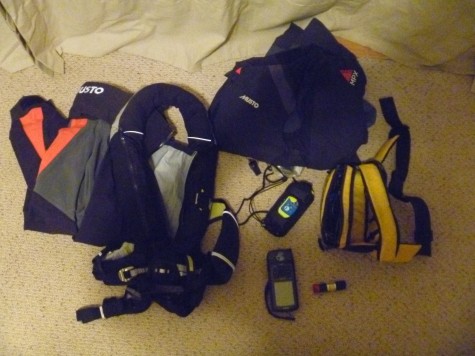
Something to bear in mind if you are travelling is that the GPS takes a while to get a new fix if you fly with it so when you first get to your destination it is best to turn it on to find itself again.
The coastguard had a few questions which would have helped in their search. Wanting to know what the crew were wearing and what the vessel looked like. So I will send my family and friends an email with a picture of the boat if I am going offshore in future. If I am wearing foulweather gear it is always Musto and all black.
I hope everyone can take something useful away from this tragedy and I am proud of how my yacht club SFYC has pulled together and is handling it all. They have now called off the search so a total of 5 were lost http://news.yahoo.com/c-guard-ends-search-4-missing-yacht-racers-065444796–spt.html


